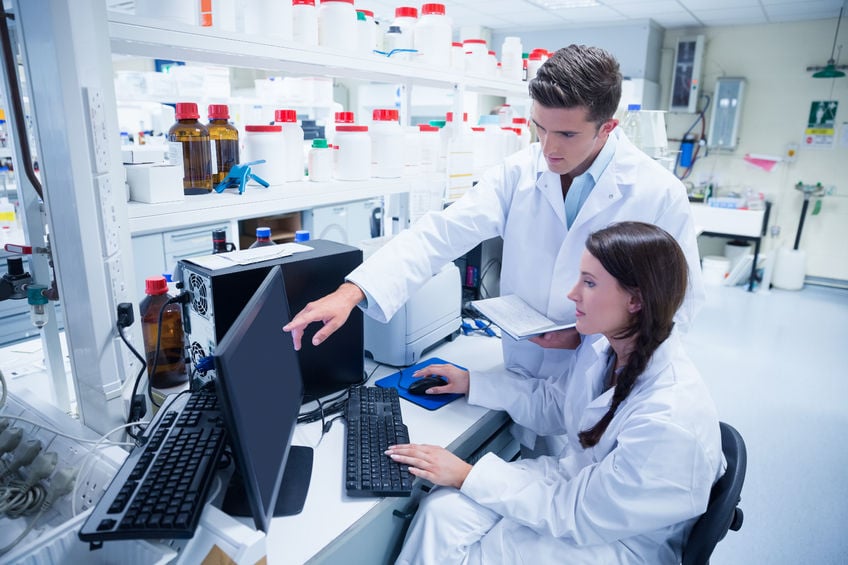Many frustrating experimental results happen because you made a mistake. In hindsight, you realize you set up the reaction incorrectly or you were rushing and messed up the purification. Mistakes happen. Sometimes, though, you cannot find any good reason for why the reaction didn’t work. Sometimes you don’t make a mistake. In that case it becomes a lab mystery, waiting to be solved or overcome. Below are four lab mysteries where experiments went awry and things were not as they seemed.
Bromination: I needed to do a benzylic bromination of a simple benzene derivative. I had a literature procedure. The starting materials were all commercially available. It is not an air-free or moisture sensitive reaction. I mixed them all together and refluxed the reaction overnight. It should have been done by morning but the TLC (thin layer chromatography) showed only starting material. Letting it go longer did not help. I set up the reaction again and let it go for a week while I did other things. There was still no sign of product.

In this sort of situation it is best to test the starting materials for purity. AIBN, a radical initiator, can go bad by itself. However, it was fine by NMR. The starting substrate was also fine. I took an NMR (nuclear magnetic resonance spectroscopy) of a very small amount of the N-bromosuccinimide (NBS) and saw a singlet as I expected. I scratched my head for a while. Everything seemed fine. Finally, I decided I was not content with just that singlet for the NBS, and decided to obtain a carbon spectrum. It should have been easy but I could not get it to dissolve and when I ran the carbon, it was blank. I started to add more to the sample when I noticed how the NBS looked when it was dried on the sides of a flask. It fell off in a familiar, powdery way and I began to suspect the stuff in the 1 kg bottle was not NBS at all. I took an IR to confirm. There was no carbonyl stretch. This stuff was silica. Some good-for-nothing replaced the contents of a 1 kg jar with silica and did not change the label! He or she did not even clean the jar, considering the trace NBS I saw in the proton. I can laugh about it now. I was furious back then. The reaction worked when I used real NBS.
Photoreaction: A post-doc had to do a photochemical reaction to make a graphitic ribbon. This is a well-known procedure, often called the Mallory photooxidation, and my group had been doing it for years with success. In this reaction, the photocyclization is pushed forward with the use of iodine as a radical reagent. It abstracts a proton from the cycle and forms hydrogen iodide, HI. This is a strong acid that may degrade the product so a trapping agent is used, usually propylene oxide. It reacts with HI instead because there is a lot more of it than product. Propylene oxide is something beneficial and nobody had ever seen harm come of using it.

The post-doc did not obtain the cyclized product he expected but instead got some mess. He submitted some for mass spectrometry and puzzled over the NMR. When the mass spec came back, eventually he realized that propylene oxide was adding into his molecule, at least two times. The substance that was meant to protect his molecule was ruining it. The post-doc did not bother to figure out how or why propylene oxide was adding into his molecule. He just used the weak base potassium carbonate to scavenge HI instead. It does not seem worth pursuing some mysteries in science.
Water: A reaction was giving me trouble and I decided water was the reason I had no product formed. The reaction was a deprotonation of a terminal alkyne with n-butyllithium. If enough water is around, it will react with n-butyllithium and not the alkyne. I decided the alkyne must be wet because I was a second year and that was all I could think of. A way of removing water from solids is to dissolve them in toluene and evaporate off the toluene. Toluene forms an azeotrope with water and pulls it off when it evaporates. Doing this three times should dry the material quite well.
I did this late on a Friday. I pulled off the toluene three times, careful not to let stuff bump. I took an NMR. It still had water. I pulled off toluene three times again…less careful about not letting it bump this time. I took an NMR. It still had water. Suddenly, before doing it again, I had a brain wave and took an NMR of the blank NMR solvent. It had the same amount of water as the alkyne. The alkyne was not wet and following some advice from my boss, I realized the reaction had actually worked the first time. The product was just so insoluble that I did not see it by NMR until I warmed it up (I only saw the byproduct at room temperature). I did not tell my boss how I discovered that NMR solvents can be quite wet.
Thick film: A post-doc made a lot of a valuable precursor for various graphitic ribbons. The precursor itself already takes at least seven steps to make, including a bottle-neck of a photocyclization, and the post-doc was proud of the large amount he had made. He rotovapped the stuff down into a flask. It formed what looked like a thick pink film. Oftentimes, chemists will blow air on things after rotovapping them to get rid of any residual solvent fumes. The ribbon seemed firmly attached to the sides of the flask so the post-doc put an air tube inside and left it for a bit. When he came back, the floor of his hood was pink. The “thick film” was actually on the verge of becoming powder and the air helped it do so all over the hood. The poor post-doc collected it off the floor of his hood, including random paper towels, and ran a column on it again. He got most of it back.

Quartzy is the world’s No. 1 lab management platform. We help scientists easily organize orders, manage inventory, and save money. We’re free and always will be. Visit Quartzy.com or reach out at info@quartzy.com.
Interested in writing for The Q? Send us an email!
Share this:
Tags: advice, laboratory, chemistry

Margarita Milton
Margarita Milton grew up in New York City. She received her BS in Chemistry from Stony Brook University after working on the synthesis of aromatic belts in the lab of Nancy Goroff. She is currently a graduate student in the Nuckolls Lab at Columbia University, where she creates novel architectures involving perylene diimides. In her spare time, Margarita likes to read and write.




